Related Research Articles
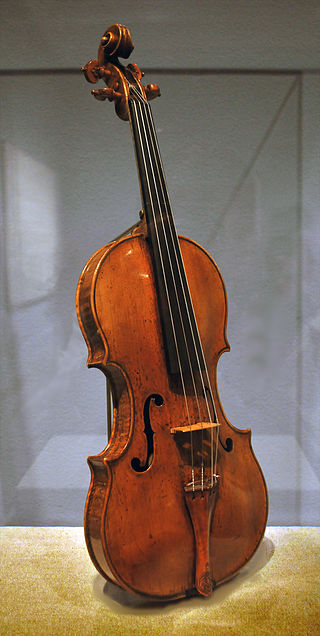
Amati is the last name of a family of Italian violin makers who lived at Cremona from about 1538 to 1740. Their importance is considered equal to those of the Bergonzi, Guarneri, and Stradivari families. Today, violins created by Nicolò Amati are valued at around $600,000. Because of their age and rarity, Amati instruments are mostly kept in museum or private collections and are seldom played in public.

The term string quartet can refer to either a type of musical composition or a group of four people who play them. Many composers from the mid-18th century onwards wrote string quartets. The associated musical ensemble consists of two violinists, a violist, and a cellist.
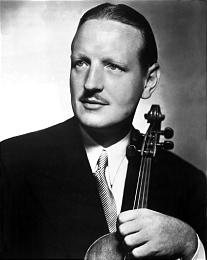
William Primrose CBE was a Scottish violist and teacher. He performed with the London String Quartet from 1930 to 1935. He then joined the NBC Symphony Orchestra where he formed the Primrose Quartet. He performed in various countries around the world as a soloist throughout his career. He also taught at several universities and institutions. He authored several books on viola technique.
A piano trio is a group of piano and two other instruments, usually a violin and a cello, or a piece of music written for such a group. It is one of the most common forms found in classical chamber music. The term can also refer to a group of musicians who regularly play this repertoire together; for a number of well-known piano trios, see below.

Carl Philipp Stamitz was a German composer of partial Czech ancestry. He was the most prominent representative of the second generation of the Mannheim School.

The Emerson String Quartet, also known as the Emerson Quartet, is an American string quartet that was initially formed as a student group at the Juilliard School in 1976. It was named for American poet and philosopher Ralph Waldo Emerson and began touring professionally in 1976. The ensemble taught in residence at The Hartt School in the 1980s and is currently (2022) the quartet in residence at Stony Brook University. Both of the founding violinists studied with Oscar Shumsky at Juilliard, and the two alternated as first and second violinists for the group. The Emerson Quartet was one of the first such ensembles with the two violinists alternating chairs.
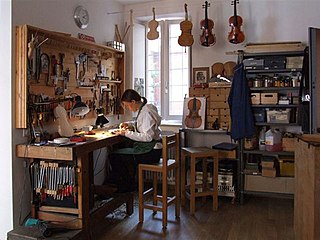
A luthier is a craftsperson who builds or repairs string instruments that have a neck and a sound box. The word luthier is originally French and comes from the French word for "lute". The term was originally used for makers of lutes, but it came to be used in French for makers of most bowed and plucked stringed instruments such as members of the violin family and guitars. Luthiers, however, do not make harps or pianos; these require different skills and construction methods because their strings are secured to a frame.
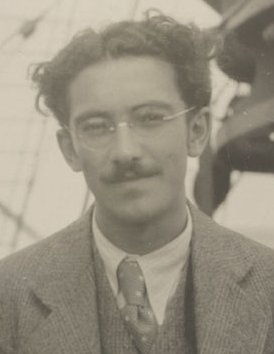
Murray Adaskin, was a Toronto-born Canadian violinist, composer, conductor and teacher. After playing violin with a band, he studied composition and became the director of the Music department of the University of Saskatchewan. Many of his compositions were written while in Victoria after his retirement.
The Brodsky Quartet is a British string quartet, formed in Middlesbrough, North Yorkshire, in 1972 as the "Cleveland Quartet". Ian Belton and Jacqueline Thomas are original members, though Paul Cassidy remains a long-standing member, joining in 1982.
Karen Tuttle was an American viola teacher, most famous for developing the Karen Tuttle Coordination Technique, which emphasizes being comfortable while playing the instrument. She began performing on violin at the age of sixteen before switching to viola in 1941. Tuttle actively performed and taught at a number of institutions until her retirement in 2005.
Simon Andrew Thomas Standage is an English violinist and conductor best known for playing and conducting music of the baroque and classical eras on original instruments.

The Hellmesberger Quartet was a string quartet formed in Vienna in 1849. It was founded by Joseph Hellmesberger Sr. and was the first permanent named String Quartet.

The Audubon Quartet (1974-2011) was an American string quartet based at residencies at Marywood College in Scranton, Pennsylvania (1974-1979) and at Virginia Tech in Blacksburg, Virginia (1980-2001).
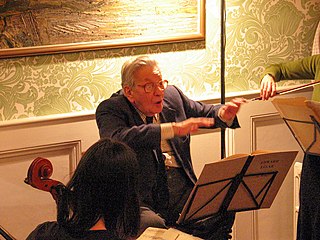
Emanuel Hurwitz was a British violinist. He was born in London to parents of Russian-Jewish ancestry.
Andrea Guarneri was an Italian luthier, musician and founder of the Casa Guarneri. He is the most important student of Nicola Amati and grandfather of one of the best luthiers, Bartolomeo Giuseppe Guarneri, del Gesù.
The St. Lawrence String Quartet is a Canadian string quartet, and one of Canada's premier chamber ensembles.
The Saskatoon Symphony Orchestra (SSO) is a professional orchestra based in Saskatoon, Saskatchewan, administered by the non-profit Saskatoon Symphony Society. The orchestra was founded in 1927 as an amateur orchestra, but today has 10 core members and up to 50 sessional musicians. Arthur Collingwood, who was Professor of Music at the University of Saskatchewan, presented the first SSO concert. The SSO received major funding from the Carnegie Institute in 1931. The Canada Council, the Saskatchewan Arts Board, and the City of Saskatoon have all provided sponsorship of the SSO through the years. In the spring, the symphony holds a Saskatoon Symphony Book & Music Sale to raise funds for the orchestra. The SSO itself offers students grants and hosted a national cello competition in 1990. Dwaine Nelson was responsible for the development of a full-time core of musicians, initially with a size of six, but later expanded to the present-day ten members. In the summer of 2014, the SSO announced that Maestro Victor Sawa would move into the position of Conductor Emeritus at the end of the 84th season. In March 2015, the SSO announced Eric Paetkau as the 16th Music Director of the orchestra.

Nicola Amati, Nicolò Amati or Nicolao Amati was an Italian master luthier from Cremona, Italy. Amati is one of the most well-known luthiers from the Casa Amati. He was the teacher of illustrious Cremonese School luthiers such as Andrea Guarneri and Giovanni Battista Rogeri. While no clear documentation exists for their being apprentices in his shop, Amati may also have apprenticed Antonio Stradivari, Francesco Rugeri, and Jacob Stainer, as their work is heavily influenced by Amati.

David L. Fulton is a private collector of Cremonese instruments. Born in 1944, he grew up in Eugene, Oregon, playing the violin from an early age. He studied mathematics at the University of Chicago, and was concertmaster of the University of Chicago Orchestra while he was there.

Andrea Amati was a luthier, from Cremona, Italy. Amati is credited with making the first instruments of the violin family that are in the form we use today. Several of his instruments survive to the present day, and some of them can still be played. Many of the surviving instruments were among a consignment of 38 instruments delivered to Charles IX of France in 1564.
References
- ↑ Mihalovic, John A. "Norma Lee Bisha". thecanadianencyclopedia.ca. The Canadian Encyclopedia. Retrieved 9 January 2022.
- ↑ "Michael Bowie". discogs.com. Discogs. Retrieved 9 January 2022.
- ↑ "Edward Bisha". thecanadianencyclopedia.ca. The Canadian Encyclopedia. Retrieved 9 January 2022.
- 1 2 Ward, Garnet; Nygaard King, Betty (2017-01-09). "Amati Quartets". The Canadian Encyclopedia . Retrieved 2020-04-16.
- ↑ Fuller, Cam. "Violinist Swan...Sept 2017". thestarphoenix.com. The Saskatoon StarPhoenix. Retrieved 9 January 2022.
- 1 2 "Elixir Ensemble". elixirensemble.com. Elixir Ensemble. Retrieved 9 January 2022.
- ↑ "Linda Bardutz". livevictoria.com. Live Victoria. Retrieved 9 January 2022.
- ↑ "Luke Hnenny". lesamateursvirtuoses.com. Les Amateurs Virtuoses. Retrieved 9 January 2022.
- ↑ "Touchdown for Dreams – Archive | 2015 | Marla's Dream". Cameco . 2015-06-09. Retrieved 2020-04-16.
- ↑ Charlton, Jonathan. "Amati Quartet makes Haydn shine...Nov 2016". thestarphoenix.com. The Saskatoon StarPhoenix. Retrieved 9 January 2022.
- ↑ Fuller, Cam (2017-09-22). "Saskatoon loses passionate violinist Marla Cole". The StarPhoenix . Retrieved 2020-04-16.
- ↑ "Amati Quartet". mcnallyrobinson.com. McNally Robinson. Retrieved 9 January 2022.
- ↑ "Amati Quartet's new album dedicated to Marla Cole". The StarPhoenix . 2018-02-21. Retrieved 2020-04-16.
- ↑ "Marla Cole Memorial Fund". Saskatchewan Community Foundation. 29 November 2018. Retrieved 2020-04-16.
- ↑ "Ménestrel, Aug 2021". musiqueroyale.com. Musique Royale. Retrieved 9 January 2022.
- ↑ "Sound Xchange". cbc.ca. Canadian Broadcasting Corporation. Retrieved 9 January 2022.
- ↑ "Ritornello Chamber Music Festival". facebook.com. Facebook. Retrieved 9 January 2022.
- Other sources
- Lorraine Omness (2008). "About the Amati instruments". University of Saskatchewan. Retrieved 2008-04-29.
- U of S Archives (2008). "1969: Amati Quartet Makes its Debut". Deo et Patriae. University of Saskatchewan. Retrieved 2008-04-29.